My hair has been through it—bleach, heat styling, and the occasional overzealous brushing session. So, when I heard about bond-building treatments like Living Proof Triple Bond Complex and K18, I was all in.
This article is my journey to figure out which one’s worth your time and money. I’ll break down their key features, weigh the pros and cons, and share my real-world experience using both.
By the end, you’ll know which product might be your hair’s new best friend.
A Brief Comparison Table
| Feature | Living Proof Triple Bond Complex | K18 Leave-In Molecular Repair Mask |
| Primary Function | Repairs all three hair bonds (hydrogen, ionic, covalent) | Repairs keratin chains and disulfide bonds |
| Application | Post-shampoo and conditioner, leave-in, 10-minute wait | Post-shampoo, no conditioner, leave-in, 4-minute wait |
| Heat Activation | Recommended for best results | Not required |
| Usage Frequency | Once a week | Every 4-6 shampoos initially, then as needed |
| Key Ingredient | 3D Fortifying Technology (patent-pending) | K18PEPTIDE (bioactive peptide) |
| Hair Types | All, especially damaged or color-treated | All, especially chemically treated |
| Price (1.5 oz) | ~$45 | ~$75 (1.7 oz) |
| Texture | Lightweight cream | Lightweight cream |
| Scent | Chemical-like, mild | Subtle, clean |
My Hair’s Cry For Help
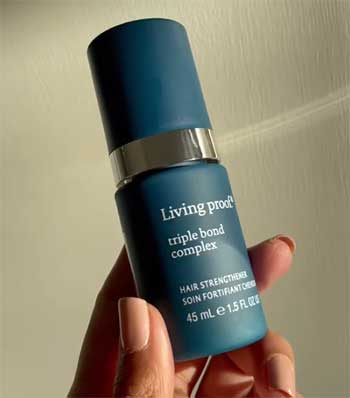
I’ve been bleaching my hair for years, and let’s just say it’s not exactly thriving.
Split ends, frizz, and a texture that sometimes feels like straw—it’s a mess.
I needed a solution that could actually repair the damage, not just slap a glossy finish on it.
That’s when I stumbled across bond-building treatments.
These aren’t your average conditioners; they work on a molecular level to rebuild the bonds that make your hair strong and elastic.
Living Proof Triple Bond Complex and K18 kept popping up in reviews, so I decided to put them to the test.
What Are Bond-Building Treatments?
Before we get into the juicy details, let’s talk about what makes these products special. Your hair is made of keratin, a protein held together by three types of bonds: hydrogen, ionic, and covalent (disulfide).
Heat, bleach, and even brushing can break these bonds, leaving your hair weak and prone to breakage. Bond builders like Living Proof and K18 step in to repair or reconnect these bonds, restoring strength and shine.
Think of them as the structural engineers of your haircare routine.
Living Proof Triple Bond Complex: The Science Geek’s Dream
Living Proof is all about science-backed solutions, and their Triple Bond Complex is no exception. Launched in 2022, it’s a leave-in treatment designed to repair all three types of hair bonds while creating new ones.
Its secret weapon?
A patent-pending 3D Fortifying Technology that forms a network within the hair fiber to rebuild and protect. I was intrigued by the claim that it makes hair eight times stronger after just one use.
How I Used Living Proof Triple Bond Complex?
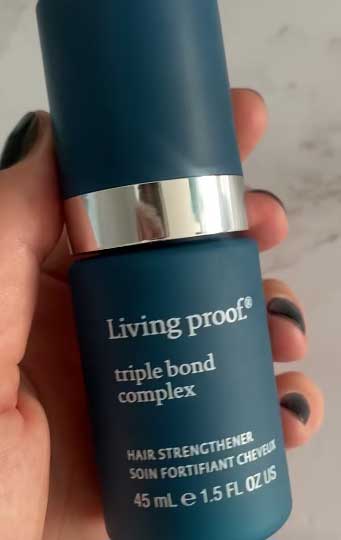
The instructions are straightforward: shampoo and condition as usual, then apply two to three pumps to damp hair.
Comb it through, wait 10 minutes, and blow-dry for best results (heat activates the formula).
I have shoulder-length, color-treated hair, so I stuck with two pumps.
The texture is lightweight, almost like a watery cream, but the smell?
A bit chemical-like, which wasn’t my favorite.
After waiting the full 10 minutes—usually while doing my skincare—I’d blow-dry and style as usual.
What I Loved (Pros)
- Ease of Use: It slots right into your routine after conditioner, so no need to overhaul your shower habits. I appreciated how low-maintenance it felt compared to pre-shampoo treatments.
- Visible Results: After one use, my hair was noticeably smoother and shinier. Over four weeks, I saw less fallout and fewer flyaways, especially when straightening.
- Strength Boost: In a 75-person study, 85% reported stronger hair, and I could feel it. My ends, usually prone to splitting, held up better between trims.
- Heat Protection: It offers protection up to 450°F, a godsend for someone like me who loves a sleek blowout.
- Long-Lasting Effects: The formula keeps working through multiple shampoos, so you only need it once a week.
What I Didn’t Love (Cons)
- Heat Dependency: If you’re team air-dry like I sometimes am, you miss out on the full effect without a blow-dryer. I tried diffusing my waves, but it wasn’t quite the same.
- Pricey for Some: At $45 for 1.5 oz, it’s not cheap, though I found it lasted a while with weekly use.
- Scent Issues: That chemical smell lingered a bit, which was a bummer compared to more pleasant hair products.
- Waiting Time: Ten minutes isn’t forever, but it feels like it when you’re in a rush.
My Experience
After a month of weekly use, my hair felt stronger and looked healthier. The shine was undeniable, especially when I blow-dried. My natural waves held their shape better, and I noticed less frizz on humid days.
However, I wasn’t thrilled about the heat requirement. On days I skipped the blow-dryer, the results were less dramatic—still good, but not game-changing. It’s a solid choice if you’re okay with a bit of heat styling and don’t mind the price tag.
K18 Leave-In Molecular Repair Mask: The Minimalist’s Choice
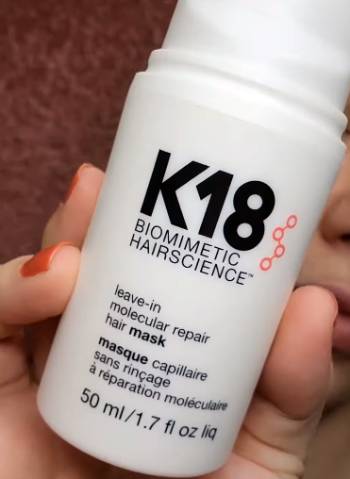
K18 burst onto the scene with its Leave-In Molecular Repair Mask, and it’s been hyped as Olaplex’s biggest rival.
Its star ingredient is K18PEPTIDE, a bioactive peptide that reconnects broken keratin chains and repairs disulfide bonds.
The brand claims it restores 91% of hair’s original strength and 94% of its elasticity in just four minutes.
Rihanna’s a fan, so I was curious to see if it lived up to the buzz.
How I Used K18 Leave-In Molecular Repair Mask?
K18’s routine is unique: shampoo, skip conditioner, towel-dry, and apply one to three pumps (I used two). Work it through from ends to roots, wait four minutes, and style—no rinsing.
The no-conditioner rule threw me off since my curly hair loves hydration, but I followed the instructions. The cream is lightweight with a subtle, clean scent that I preferred over Living Proof’s.
What I Loved (Pros)
- Speedy Application: Four minutes is a dream for busy mornings. I could apply it, brush my teeth, and be done.
- No Heat Needed: Unlike Living Proof, K18 works without a blow-dryer, making it perfect for air-drying or natural textures.
- Impressive Repair: After two weeks of using it every 4-6 shampoos, my hair felt softer and more elastic. Brushing was easier, with fewer tangles and less breakage.
- Versatility: It doubles as a leave-in conditioner and styling cream, saving time and product. My waves looked more defined without extra styling.
- Travel-Friendly: The 1.7 oz bottle is compact, and a little goes a long way.
What I Didn’t Love (Cons)
- Price Shock: At $75 for 1.7 oz, it’s a splurge. I winced at the checkout, though the results softened the blow.
- No Conditioner Rule: Skipping conditioner made my hair feel a bit dry initially, especially since I have thick, wavy hair. I had to lean on leave-in products post-treatment.
- Learning the Dosage: The “one pump” starting point felt stingy for my hair. I needed two to cover everything, and overuse can make hair feel heavy.
- Initial Commitment: The 4-6 consecutive uses for first-time damaged hair felt like a lot, though it tapers off to maintenance.
My Experience
K18 was a game-changer for convenience. I loved how seamlessly it fit into my routine—no extra steps or heat styling required. After the initial 4-6 uses, my hair was noticeably softer and shinier, with fewer knots.
My bleached ends looked less frazzled, and I could go longer between trims. The downside? That first week without conditioner was rough—my hair craved moisture. Once I added a lightweight leave-in spray, things balanced out. It’s ideal if you want fast results and minimal fuss, but the price stings.
Head-to-Head Comparison of Living Proof Triple Bond Complex And K18
Both products aim to repair damaged hair, but they approach it differently. Living Proof’s Triple Bond Complex targets all three hair bonds (hydrogen, ionic, covalent) and creates new ones, making it a powerhouse for long-term strength.
K18 focuses on reconnecting keratin chains and disulfide bonds with its peptide technology, emphasizing molecular repair. Here’s how they stack up in key areas:
- Application and Routine
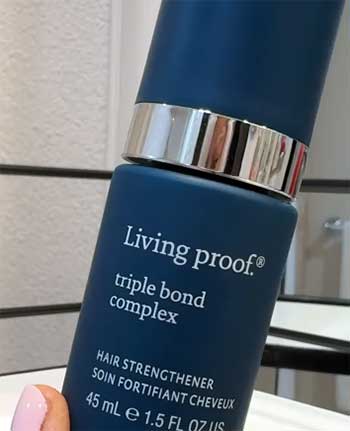
Living Proof feels like a traditional treatment: post-shampoo and conditioner, apply, wait, and style.
The 10-minute wait and heat activation make it slightly more involved, but it’s easy to incorporate if you already blow-dry.
K18, on the other hand, is minimalist.
Skipping conditioner and waiting just four minutes makes it faster, but the no-conditioner rule can be a hurdle for dry or curly hair types like mine.
K18 wins for speed, while Living Proof gets points for fitting into standard routines.
- Results and Performance
Both delivered smoother, shinier hair, but the results varied. Living Proof gave me more immediate shine and strength, especially with heat styling. My hair felt thicker and more resilient after a month, with less fallout. K18’s strength was in elasticity—my hair bounced back better after brushing or styling.
It also worked wonders on my natural waves, defining them without extra products. For dramatic, blowout-ready results, Living Proof edged out; for low-maintenance repair, K18 took the crown.
- Price and Value
Price is where things get tricky. Living Proof’s $45 for 1.5 oz feels steep but more palatable than K18’s $75 for 1.7 oz. Both last a while with sparing use (I got about 10-12 applications per bottle), but K18’s higher cost demands confidence in its results.
If budget’s a concern, Living Proof is the more accessible choice. For those willing to invest, K18’s convenience and peptide tech might justify the splurge.
- Hair Type Suitability
Both claim to work for all hair types, but I found nuances. Living Proof’s lightweight formula suited my medium-thick, wavy hair, especially when straightened. Its heat protection made it a go-to for color-treated or heat-styled hair.
K18’s thicker texture worked better for my wavy, chemically treated hair when air-dried, as it doubled as a styling cream. Curly or coarse hair might prefer K18 for its hydrating benefits, while fine hair could lean toward Living Proof to avoid weighing it down.
My Real-World Test: A Month of Each
To give both a fair shot, I used Living Proof for four weeks, then switched to K18 for another four. Here’s how it went:
- Living Proof Month
Week one was a revelation. My hair looked glossier after the first blow-dry, and my ends felt less brittle. By week three, I noticed less hair in my brush—a win for my overprocessed strands.
The 10-minute wait was annoying on busy days, and I skipped heat a few times, which dulled the results. By the end, my hair was stronger and shinier, but I wished for a better scent and less heat reliance.
- K18 Month
K18’s quick application was a lifesaver. After the first use, my hair felt softer, and by the second week, my waves were more defined. The no-conditioner rule was tough—my hair felt parched until I added a leave-in spray.
By week four, my hair was more elastic, and breakage was minimal. The price still stung, but the convenience and results made it tempting to stick with.
Which One’s Right for You?
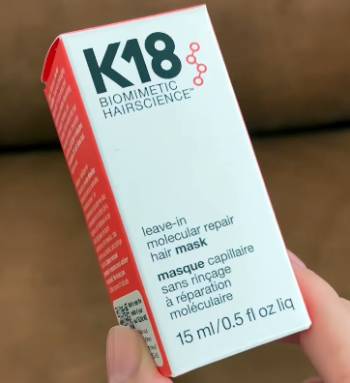
Choosing between Living Proof and K18 depends on your hair needs and lifestyle.
If you love heat styling and want a treatment that fits your existing routine, Living Proof is your match.
Its strength-building and heat protection are perfect for color-treated or damaged hair.
If you’re all about simplicity and air-drying, K18’s quick, no-heat approach is a winner, especially for curly or chemically treated hair.
For me, K18 edged out slightly because I value speed and versatility. But Living Proof’s affordability and strength gains kept it in close contention. Try a mini size of each (Living Proof’s 0.5 oz is $20; K18’s 0.17 oz is $30) to see what works for your hair before committing.
Frequently Asked Questions (FAQ)
Living Proof Triple Bond Complex is a strong contender, offering similar repair with a different approach. Olaplex No.3 is another solid option, especially for budget-conscious folks. It depends on your hair’s needs.
Once a week is recommended, but you can use it more if your hair is very damaged. Apply to clean, damp hair for best results.
K18’s faster application and no-rinse formula make it more convenient, but Olaplex No.3 is cheaper and great for severe damage. I found K18 slightly more effective for elasticity, but both are excellent.
You don’t need to stop, but after the initial 4-6 consecutive uses, switch to maintenance (once every 1-2 weeks) unless your hair needs ongoing repair.
Conclusion: Your Hair, Your Choice
You’ve got two heavyweights here, and neither is a dud. Living Proof Triple Bond Complex is your go-to if you want stronger, glossier hair with a bit of heat styling in your routine. K18 is perfect if you’re after quick, no-fuss repair that works without a blow-dryer.
I’ve laid out the pros, cons, and my own experience to help you decide. Test them out, see what your hair loves, and let me know how it goes—your locks deserve the best!
